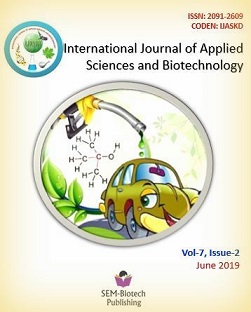Environmental Impact On Morphological and Anatomical Structure of Ricinus communis L. Leaves Growing in Kathmandu, Nepal
DOI:
https://doi.org/10.3126/ijasbt.v7i2.24652Keywords:
Leaf area, Leaf dry mass, Stomata frequencyAbstract
The current study was done to examine the impact of environmental pollution on morphology and anatomy of leaf of Ricinus communis L. of Kathmandu. The comparative study was done between the plants of high polluted sites i.e Ringroad sides and less polluted sites i.e Raniban forest of Kathmandu. The plants from both sites showed visible morphological and anatomical changes in leaves. These both study sites were found with similar soil factors and climatic factors. Reductions in some morphological and anatomical features were observed in leaves growing in highly polluted site. Reduction in leaf area, petiole length, thickness of palisade layer and thickness of spongy parenchyma was noticed in the leaves from highly polluted sites of Kathmandu. Other morphological and anatomical features such as leaf dry mass content, stomata frequency, thickness of cuticle and size of epidermal cells were noticed to be increased in leaves from highly polluted sites.
Int. J. Appl. Sci. Biotechnol. Vol 7(2): 274-278




